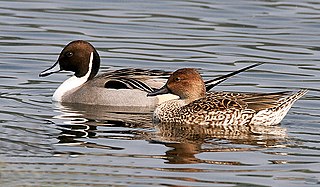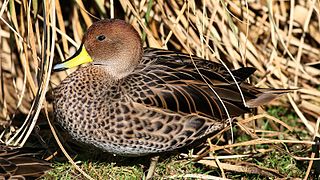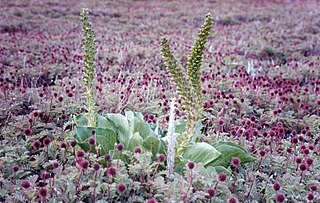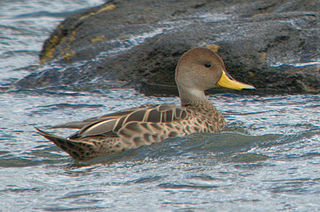See also
- All pages with titles containing pin-tailed
- Pin the tail on the donkey, traditional children's game
Pintail may refer to:

The pintail or northern pintail is a duck species with wide geographic distribution that breeds in the northern areas of Europe and across the Palearctic and North America. It is migratory and winters south of its breeding range to the equator. Unusually for a bird with such a large range, it has no geographical subspecies if the possibly conspecific duck Eaton's pintail is considered to be a separate species.

The white-cheeked pintail, also known as the Bahama pintail or summer duck, is a species of dabbling duck that is spottily distributed throughout South America and the Caribbean. It was first described by Carl Linnaeus in his landmark 1758 10th edition of Systema Naturae under its current scientific name.

The mottled duck or mottled mallard is a medium-sized species of dabbling duck. It is intermediate in appearance between the female mallard and the American black duck. It is closely related to those species, and is sometimes erroneously considered a subspecies of the former.

The yellow-billed teal is a South American species of duck. Like other teals, it belongs to the diverse genus Anas; more precisely it is one of the "true" teals of subgenus Nettion. It occurs in Argentina, the Falkland Islands, Chile, Peru, Bolivia, Uruguay, and Brazil. It has also established itself in South Georgia, where it was first recorded breeding in 1971, and has been recorded as far east as Tristan da Cunha. It inhabits freshwater wetlands, preferring palustrine habitat to rivers. Considering its wide range and local abundance, it is not considered threatened by the IUCN.

The yellow-billed pintail is a South American dabbling duck of the genus Anas with three described subspecies.

The Scotia Sea is a sea located at the northern edge of the Southern Ocean at its boundary with the South Atlantic Ocean. It is bounded on the west by the Drake Passage and on the north, east, and south by the Scotia Arc, an undersea ridge and island arc system supporting various islands. The sea sits atop the Scotia Plate. It is named after the expedition ship Scotia. Many icebergs melt there.

The South Georgia pintail, also misleadingly known as the South Georgian teal, is the nominate subspecies of the yellow-billed pintail, a duck in the dabbling duck subfamily Anatinae. It is endemic to the large (3,756 km2) subantarctic island of South Georgia and its accompanying archipelago, and is a vagrant to the South Sandwich Islands. It was among the birds noted by James Cook in January 1775, on the occasion of the first recorded landing on South Georgia, and was formerly considered a full species.

The Southern Indian Ocean Islands tundra is a tundra ecoregion that includes several subantarctic islands in the southern Indian Ocean.

The Chilean pintail, also known as the golden peck duck or brown pintail, is a subspecies of the yellow-billed pintail, a duck in the dabbling duck subfamily Anatinae. Its local names are pato jergón grande, pato maicero and pato piquidorado in Spanish, and marreca-parda or marreca-danada in Portuguese.
Niceforo's pintail is an extinct subspecies of the yellow-billed pintail, a duck in the dabbling duck subfamily Anatinae. One of three subspecies, it was found in central Colombia but became extinct in the 1950s, being last seen in 1952.
Teal is a blue-green color .